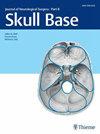上颌窦晚期鳞状细胞癌的治疗方法分析:一项国家癌症数据库研究
IF 0.9
4区 医学
Q3 Medicine
引用次数: 0
摘要
简介:cT4a和cT4b期SCCa通常需要辅助或新辅助治疗的多模式治疗。本研究旨在评估不同治疗方式对单纯上颌窦cT4a-b期SCCa患者生存结果的影响。方法:利用国家癌症数据库(NCDB)进行多变量生存分析,评估2004年至2020年诊断的患者的治疗方式。对变量进行Cox风险回归。结果:本研究共发现上颌窦SCCa患者1788例,其中71.2%为cT4a。年龄增加、Charlson-Deyo评分≥1和未分化/间变性分级与较差的生存率相关。多因素分析显示,在整个队列(cT4a-b)中,新辅助治疗的风险比最低(HR 0.574, 95% CI0.370 - 0.892)。新辅助治疗加手术、辅助治疗加手术和单独手术显示cT4a-b肿瘤的调整5年生存率最高。另一方面,在多因素分析中,单纯放疗的风险比最高(1.939,95% CI 1.555-2.418),调整后5年生存率最低。结论:上颌晚期SCCa的多模式治疗对不同肿瘤分期的预后有不同的影响。我们的研究结果表明,手术加新辅助治疗和手术加辅助治疗与更高的生存率相关。年龄增加、Charlson-Deyo评分≥1和未分化/间变性分级与较差的生存率相关。需要进一步的随机对照试验来量化这些治疗对晚期疾病的生存和器官保留的治疗益处。本文章由计算机程序翻译,如有差异,请以英文原文为准。
Analysis of Treatment Modalities for Advanced Stage Squamous Cell Carcinoma of the Maxillary Sinus: A National Cancer Database Study
Introduction: Stage cT4a and cT4b SCCa typically require multimodal treatment with adjuvant or neoadjuvant therapy. This study aims to evaluate the impact of different treatment modalities on survival outcomes in patients with stage cT4a-b SCCa exclusively of the maxillary sinus. Methods: A multivariate survival analysis was conducted, evaluating treatment modalities for patients diagnosed between 2004 and 2020 utilizing the National Cancer Data Base (NCDB). Cox hazard regression was performed for variables. Results: The study identified a total of 1788 patients with SCCa of the maxillary sinuses, of which 71.2% were cT4a. Increasing age, Charlson-Deyo score ≥1, and undifferentiated/anaplastic grade were associated with worse rates of survival. Multivariate analysis revealed that neoadjuvant treatment exhibited the lowest hazard ratio (HR 0.574, 95% CI0.370 - 0.892) across the entire cohort (cT4a-b). Neoadjuvant treatment plus surgery, adjuvant treatment plus surgery, and surgery alone demonstrated the highest adjusted 5-year survival for cT4a-b tumors. On the other hand, radiation alone exhibited the highest hazard ratio (1.939, 95% CI 1.555-2.418)) in multivariate analysis and the lowest adjusted 5-year survival. Conclusion: Multimodal treatment of advanced-stage maxillary SCCa has a variable effect on outcomes by tumor stage. Our findings suggest that surgery plus neoadjuvant and surgery plus adjuvant treatment are associated with higher rates of survival. Increasing age, Charlson-Deyo score ≥1, and undifferentiated/anaplastic grade were associated with worse rates of survival. Further randomized controlled trials are required to quantify the therapeutic benefit of these treatments on survival and organ sparing in advanced-stage disease.
求助全文
通过发布文献求助,成功后即可免费获取论文全文。
去求助
来源期刊

Journal of Neurological Surgery Part B: Skull Base
CLINICAL NEUROLOGY-SURGERY
CiteScore
2.20
自引率
0.00%
发文量
516
期刊介绍:
The Journal of Neurological Surgery Part B: Skull Base (JNLS B) is a major publication from the world''s leading publisher in neurosurgery. JNLS B currently serves as the official organ of several national and international neurosurgery and skull base societies.
JNLS B is a peer-reviewed journal publishing original research, review articles, and technical notes covering all aspects of neurological surgery. The focus of JNLS B includes microsurgery as well as the latest minimally invasive techniques, such as stereotactic-guided surgery, endoscopy, and endovascular procedures. JNLS B is devoted to the techniques and procedures of skull base surgery.
 求助内容:
求助内容: 应助结果提醒方式:
应助结果提醒方式:


